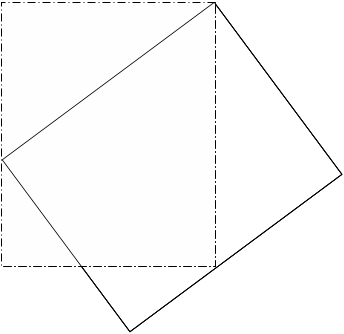GEAR UP FOR
LIFE
SCIENCE
READING:
Earth's Water
| IN THIS UNIT: Reading Passage and Practice: The
Water Cycle
|
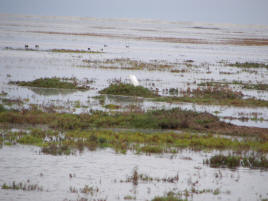 |
SUPPORT ACTIVITIES IN
READING | WRITING |
MATH |
PROJECT |
FUN
Just how much water is there on (and in) the Earth? Scientists believe that the total water supply of the world is 326 million cubic miles. (We'll find out what that means later in this unit.) That includes the water in lakes, rivers, oceans, and everywhere else! As you can see in the chart below, most of our water, or 97%, is stored in oceans.
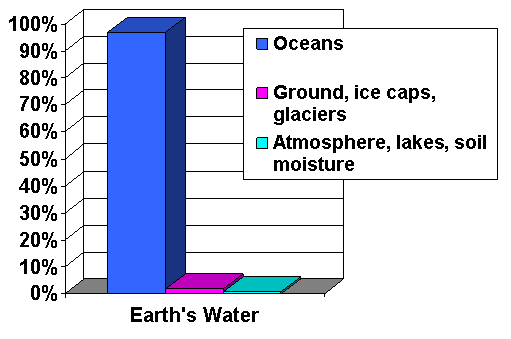
Of the freshwater on Earth, much more is stored in the ground than in lakes and rivers. More than 2,000,000 cubic miles of fresh water is stored inside the Earth.
Lakes, rivers, and other bodies of fresh water store about 60,000 cubic miles of water. To find the freshest sources of water, you would have to go to the glaciers and icecaps. They are mainly in the polar regions and in Greenland. They store 7,000,000 cubic miles of water!
The balance of water on Earth remains fairly constant over time. However, individual water molecules can come and go in a hurry. The water in the fruit you ate yesterday may have fallen as rain last year, half-way around the world! That water could also have been used thousands of years ago by a mammoth drinking from a lake!
How does water get recycled (used again) on Earth?
There are six important processes that make up the water cycle.
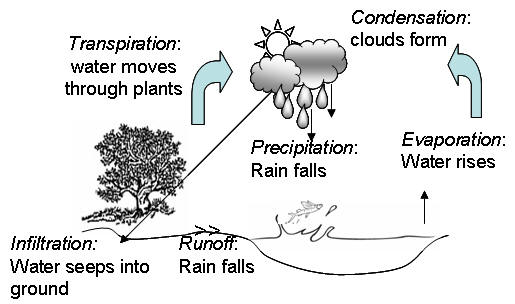
All but one of these processes ends in "tion!"
Evaporation

Evaporation is the process where a liquid changes to gas. Liquid water becomes water vapor. Place a glass with some water out in the sun. In a few days, the water is gone. It evaporated. The liquid turned to gas.During the evaporation phase, some of the water on the surface of the Earth is warmed by the sun and evaporates. During the process impurities in the water are left behind. The water that goes into the atmosphere is cleaner than it was on Earth.
Condensation

Condensation is the opposite of evaporation. Condensation occurs when the temperature of the vapor decreases or cools and forms droplets of water.droplets formed from condensation are very small, they remain suspended in the atmosphere. These millions of droplets of suspended water form clouds in the sky. They can also form fog at ground level. Water condenses into droplets only around small dust particles.When the water
Precipitation

When the temperature and atmospheric pressure are right, it rains. The small droplets of water in clouds form larger droplets and precipitation, or rain, occurs.Surface Run OffAs a result of evaporation, condensation and precipitation, water travels. It goes from the surface of the Earth, into the atmosphere, and returns to Earth again.

Much of the water that returns to Earth as precipitation runs off the surface of the land. It flows down hill into streams, rivers, ponds and lakes. Small streams flow into larger streams, then into rivers, and eventually the water flows into the ocean.Infiltration:Surface runoff is an important part of the water cycle. Through surface runoff, much of the water returns again to the oceans. That's where a great deal of evaporation occurs.
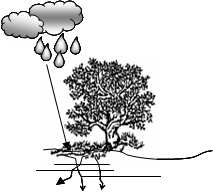
Infiltration is an important process where rain water soaks into the ground. It soaks through the soil and rock layers bellow. Some of this water finally returns to the surface as springs or puddles in low spots downhill. Some of the water remains underground and is called groundwater.Transpiration:As the water infiltrates through the soil and rock layers, many of the impurities in the water are filtered out. This filtering process helps clean the water.
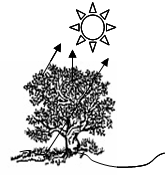
One final process is important in the water cycle. As plants absorb water from the soil, the water moves from the roots through the stems to the leaves. Once the water reaches the leaves, some of it evaporates from the leaves. This adds to the amount of water vapor in the air. This process of evaporation through plant leaves is called transpiration. In large forests, an enormous amount of water will transpire through leaves. When we cut down trees, we interrupt the water cycle. We put the Earth in danger.Term Review
Evaporation: liquid changes to gas
Condensation: Gas changes to liquid
Precipitation: droplets turn to rain
Surface Run Off: rain water runs into streams, rivers, ponds and lakes
Infiltration: rain soaks into ground
Transpiration: water moves through leaves


Two identical pieces of paper are lying one on top of the other, exactly as you see them in the image below. The sheet of paper on top has a solid border. The one under it is shown as a dotted border.
Which is bigger, the part that is covered or the part that is uncovered?
